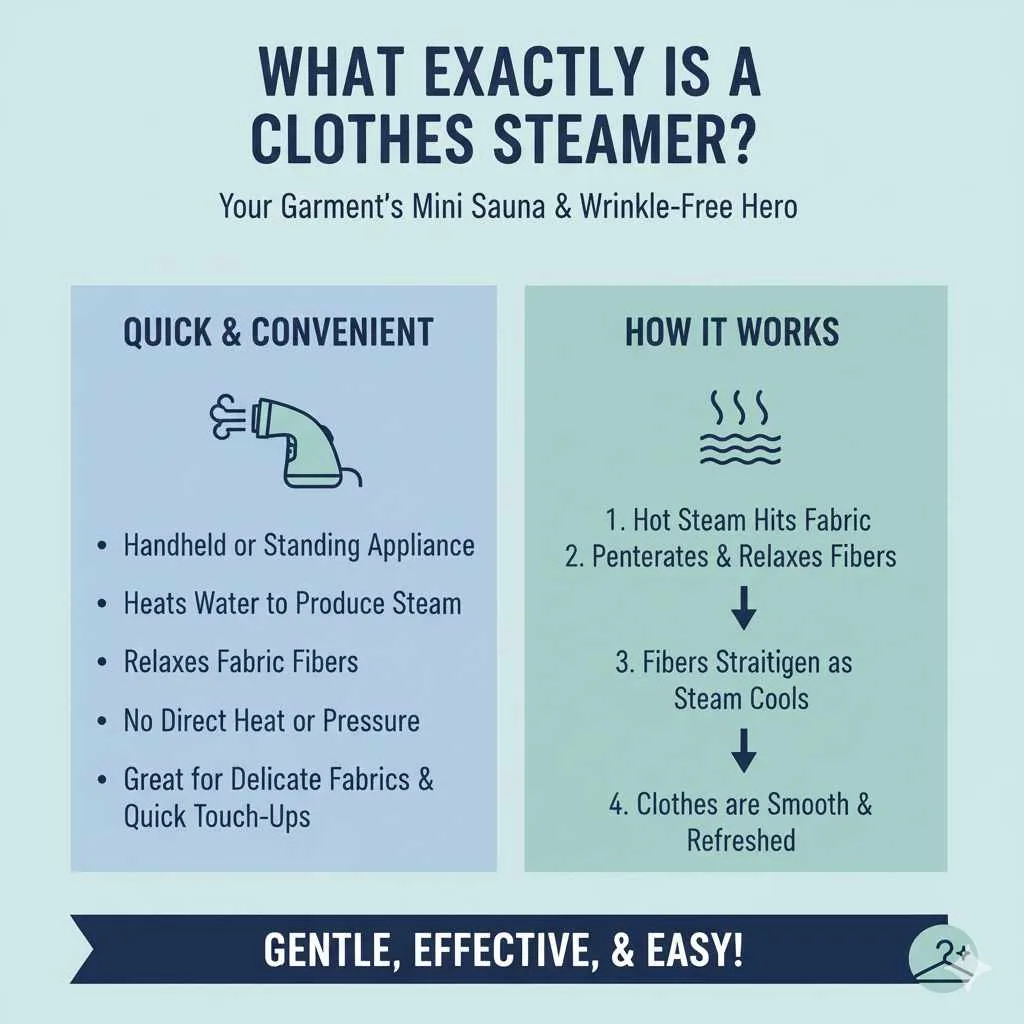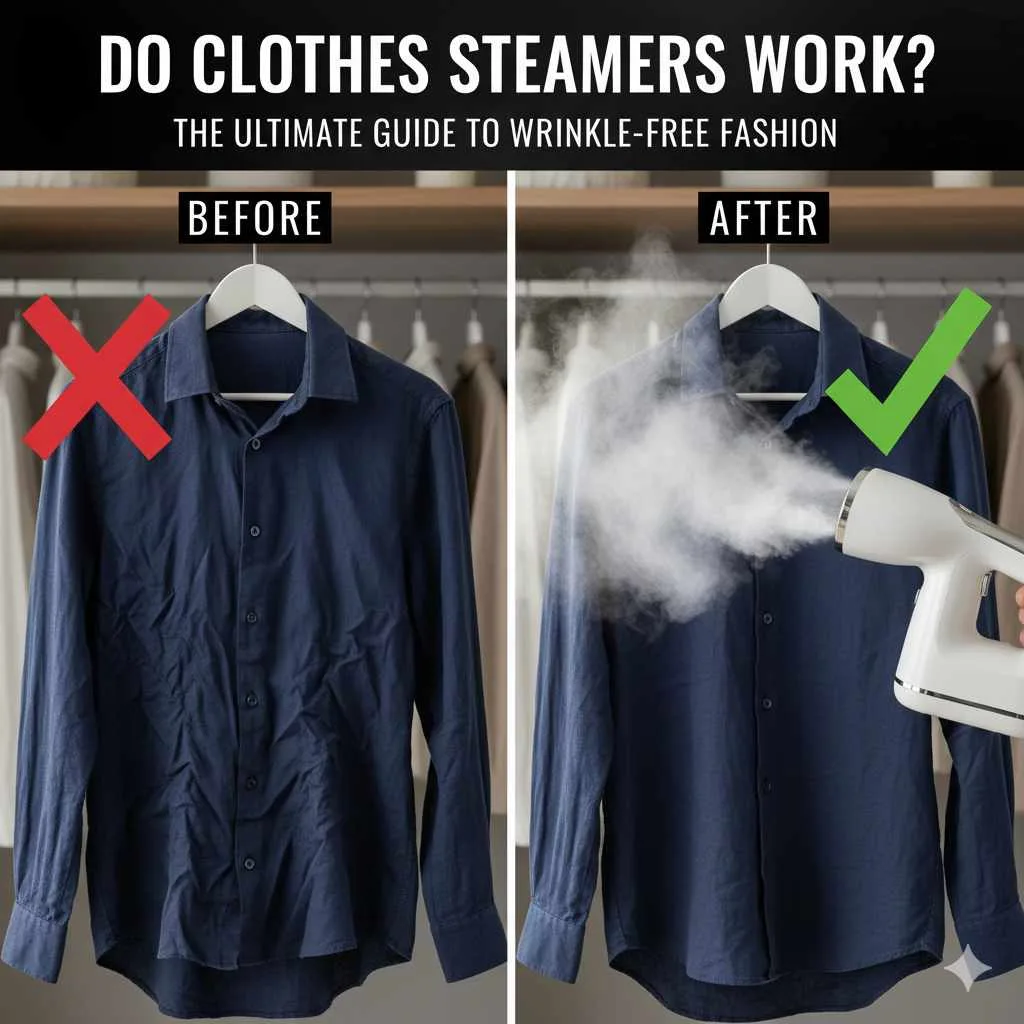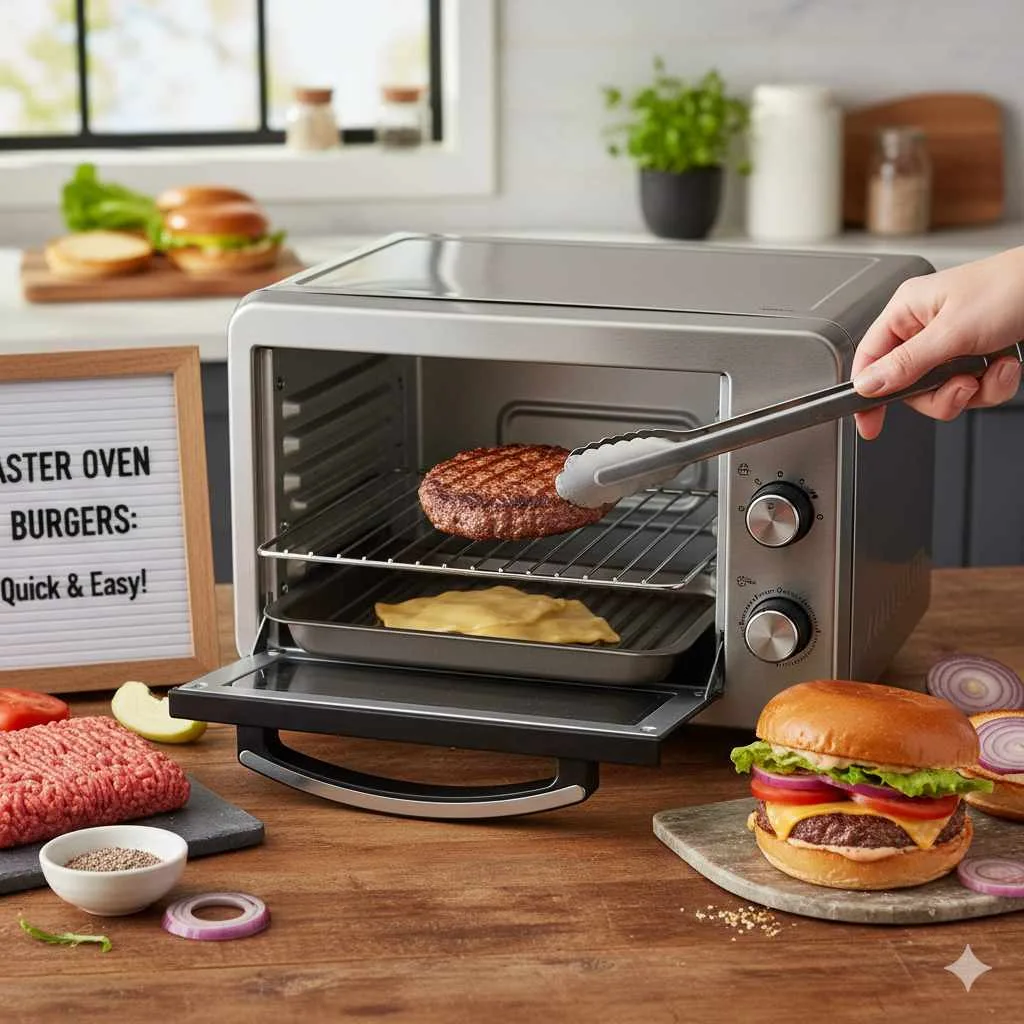Yes, clothes steamers absolutely work! They are a fantastic, quick, and easy way to remove wrinkles from most fabrics, offering a gentler alternative to traditional ironing for many garments. This essential guide will walk you through everything you need to know to get the best results.
Ever pulled a favorite outfit from the closet, only to find it looking like it slept in a gym bag? We’ve all been there! The frustration of wrinkles can really dim your shine before you even step out the door. While irons have been our go-to for ages, a growing number of us are turning to a modern marvel: the clothes steamer. But do they really work as well as they say? If you’re curious about this speedy solution for silky-smooth clothes, you’ve come to the right place. We’ll demystify clothes steamers, explain how they work their magic, and guide you on how to use one like a pro. Get ready to refresh your wardrobe with confidence!
What Exactly is a Clothes Steamer?
Think of a clothes steamer as a mini sauna for your garments. It’s a handheld or standing appliance that heats water to produce steam. This hot steam then relaxes the fabric fibers, allowing wrinkles and creases to fall out naturally without direct heat or pressure from an iron. They are super convenient, especially for delicate fabrics that might get scorched by an iron, or for quick touch-ups when you’re in a hurry.
How Does a Steamer Remove Wrinkles?
It’s all about the steam! When the hot steam hits the fabric, it penetrates the fibers and causes them to expand and relax. As the steam cools and the fabric dries, the fibers straighten out, leaving your clothes smooth and refreshed. It’s a gentler process than ironing, which uses direct heat and pressure. This is why steamers are often recommended for delicate materials.

Do Clothes Steamers Work on All Fabrics?
While clothes steamers are incredibly versatile, it’s important to understand that their effectiveness can vary depending on the fabric type and the severity of the wrinkles.
Fabrics Where Steamers Shine
Steamers are fantastic for a wide range of materials and situations. They are particularly excellent for:
- Delicates: Silk, satin, chiffon, lace, and other fine fabrics can be easily smoothed without the risk of burning or leaving shiny marks that an iron might cause.
- Flowy Garments: Dresses with ruffles, gathered skirts, or wide sleeves benefit greatly from steaming, as the steam can reach all the nooks and crannies.
- Heavily Textured Fabrics: Fabrics like velvet, corduroy, and linen can be revitalized with steam, helping to lift the pile and remove creases.
- Quick Refreshers: For clothes that aren’t heavily wrinkled but just need a quick refresh after being stored, a steamer is your best friend.
- Garments with Embellishments: Beads, sequins, or delicate appliques can often be steamed safely, whereas ironing them could cause damage.
- Sportswear and Synthetics: Many synthetic fabrics, which can be sensitive to high heat, respond beautifully to steaming.
Fabrics That Might Require More Effort (or an Iron)
While steamers are great, some fabrics and wrinkles are tougher customers. For materials like very thick cotton, denim, or heavily creased garments, you might find that a steamer takes a bit more time and effort, or that an iron still provides a sharper, crisper finish. For these, you might need to:
- Pre-treat: Sometimes, dampening a stubborn wrinkle slightly before steaming can help.
- Multiple Passes: You might need to go over the area a few times.
- Combination Approach: For extremely stubborn creases, you might occasionally use a steamer followed by a quick touch-up with an iron on a low setting.
Always check your garment’s care label first to ensure steaming is a safe option.
Types of Clothes Steamers
There are a few main types of clothes steamers, each suited for different needs and lifestyles. Choosing the right one can make a big difference in your steaming experience.
Handheld Steamers
These are compact, portable, and perfect for quick touch-ups and travel. They are ideal for individuals and small households.
- Pros: Lightweight, easy to store, fast heat-up time, great for travel, simple to use.
- Cons: Smaller water tank means less steaming time per fill, might be less powerful for very stubborn wrinkles compared to larger models.
Cylinder/Upright Steamers
These are larger, standing units with a water tank usually attached to a pole and a hose leading to a steaming head. They offer more power and longer steaming sessions.
- Pros: Larger water capacity for extended use, more powerful steam output, often come with attachments like brushes or creasers, stable and easy to maneuver around garments.
- Cons: Take up more space, require assembly, not portable for travel.
Pressing Mats and Steaming Boards
Some steamers come with accessories like mini pressing mats or boards. These can be helpful for certain garments, allowing you to hold the fabric taut for a smoother finish. For instance, a well-designed garment steamer might often include a specialized attachment for creating crisp creases, similar to what you’d get with an iron. Many manufacturers provide these as optional add-ons to enhance the versatility of their machines.
How to Use a Clothes Steamer: A Step-by-Step Guide
Using a steamer is straightforward, but a few tips can help you get the best, most wrinkle-free results every time!
Step 1: Fill the Water Tank
Most steamers use regular tap water. However, if you’re in a hard water area, using distilled or demineralized water can help prevent mineral buildup and extend the life of your steamer. Check your steamer’s manual for specific recommendations. Ensure you don’t overfill the tank.
Step 2: Heat Up the Steamer
Plug in your steamer and turn it on. Depending on the model, it will typically take anywhere from 30 seconds to a couple of minutes to heat up. You’ll know it’s ready when steam starts to come out of the nozzle.
For upright steamers, this might involve waiting for an indicator light to change. Handheld models often start steaming almost immediately.
Step 3: Hang Your Garment
For best results, hang the garment you want to steam on a sturdy hanger. This allows gravity to work with the steam, helping the wrinkles to fall out more effectively. A closet rod or a doorframe can serve this purpose.
Step 4: Steam the Fabric
Hold the steamer nozzle a few inches away from the fabric. Move the nozzle in a slow, steady, downward motion. You can also gently pull the bottom of the garment taut with your free hand to help smooth out stubborn wrinkles. Be sure to keep the steamer upright to prevent water from leaking. Avoid letting the hot nozzle touch the fabric directly, as this could cause damage.
Pro Tip: For a more professional finish on shirts or pants, you can use the steamer in conjunction with a pressing cloth or a specialized creasing tool attachment, if your steamer has one. This helps to create sharper lines.
Step 5: Let it Dry Slightly
Once you’ve finished steaming, allow the garment to hang for a minute or two to dry completely. The fabric might feel slightly damp immediately after steaming. Wearing or storing it while still damp can cause new wrinkles. For more details on fabric care and the best methods, resources like The Federal Trade Commission’s guide on care labels can offer helpful advice.
Advantages of Using a Clothes Steamer
Clothes steamers offer a host of benefits that make them a valuable addition to any home. Their ease of use and gentleness on fabrics are just the beginning!
Speed and Convenience
Steamers heat up quickly and can de-wrinkle a garment in a matter of minutes. This is a huge time-saver compared to setting up an ironing board and waiting for an iron to heat up, especially for a quick morning touch-up.
Gentle on Fabrics
The steam process is less harsh on delicate materials like silk, chiffon, or synthetics. There’s no risk of scorching or leaving shiny marks, which can be a concern with traditional irons.
Portability and Travel-Friendliness
Handheld steamers, in particular, are lightweight and compact, making them perfect for packing in a suitcase to keep your clothes looking fresh while traveling.
Effective on Complex Garments
Steamers excel at smoothing out wrinkles on garments with ruffles, pleats, lace, or intricate details that are difficult to iron.
Refresh and Sanitize
While not a substitute for washing, steam can help to kill some bacteria and remove light odors from clothing, leaving them feeling fresher.
Disadvantages of Using a Clothes Steamer
While steamers are wonderful, they aren’t a perfect replacement for irons in every situation. Understanding their limitations is key.
Less Effective on Stubborn Wrinkles
For very deep creases or heavily creased fabrics like thick denim or linen, a steamer might not achieve the sharp, crisp finish that an iron can provide. Multiple passes and some manual effort might be required.
Requires Electricity and is Not Truly “Ironing”
You still need a power source. Also, if you desire a perfectly pressed, sharp crease on a dress shirt or trousers, an iron is generally superior. Steamers are more about smoothing than pressing.
Water Tank Capacity
Handheld steamers, especially, have smaller water tanks, meaning you’ll need to refill them more often for larger loads of laundry. Upright steamers have larger tanks but are less portable.
Potential for Spitting or Leaks
If not used correctly, or if they have mineral buildup, some steamers can spit water or leak, potentially staining your clothes. Using distilled water and maintaining your steamer can help prevent this.
Steamer vs. Iron: When to Use Which
Knowing when to reach for your steamer versus your iron can save your clothes and your sanity! Here’s a quick breakdown.
| Feature | Clothes Steamer | Clothes Iron |
|---|---|---|
| Best For | Delicates, quick touch-ups, travel, textured fabrics, garments with embellishments, refreshing clothes. | Crisp creases, stubborn wrinkles, heavy fabrics (denim, thick cotton), sharpening pleats. |
| Speed (Setup & Use) | Very Fast (heats up in seconds to minutes), immediate use. | Slower (requires ironing board setup, longer heat-up time). |
| Fabric Gentleness | Very gentle; low risk of scorching or damage. | Can scorch or damage delicate fabrics if heat is too high or used incorrectly. |
| Wrinkle Removal Strength | Good for light to moderate wrinkles; may struggle with deep creases. | Excellent for all wrinkle types, especially deep-set creases. |
| Portability | Handheld models are highly portable. | Generally not portable; requires a board. |
| Crispness of Finish | Softer finish; less sharp. | Achieves sharp, pressed creases and a crisp finish. |
Maintaining Your Clothes Steamer
To ensure your steamer works efficiently and lasts for years, a little regular maintenance goes a long way.
1. Descaling
Mineral deposits from water can build up inside your steamer over time, reducing its effectiveness and potentially causing spitting. Most manufacturers recommend descaling periodically, especially if you have hard water. The frequency will depend on your water type and how often you use the steamer. Consult your steamer’s manual for specific descaling instructions – they might recommend vinegar solutions or special descaling products. For optimal performance, consider using distilled or demineralized water. You can find guides on water quality and its impact on appliances from sources like local utility providers or consumer reports websites.
2. Cleaning the Nozzle
The steam nozzle can sometimes get clogged with mineral deposits or lint. Gently wipe it with a soft, damp cloth after each use or as recommended in your manual. If it looks clogged, you might need to use a small brush (like an old toothbrush) or a cotton swab to clean it carefully.
3. Proper Storage
Make sure the water tank is empty before storing your steamer, especially if you’re not going to use it for a while. This prevents stagnant water and potential bacterial growth. Store it in a cool, dry place. If it’s an upright model, ensure the cord is neatly wrapped and the hose isn’t kinked.
Steamer vs. Ironing Board
The comparison between a steamer and an ironing board is less about which is superior and more about which tool is right for the job. An ironing board is designed to provide a flat, stable surface for an iron to press against fabric. It’s essential for achieving those sharp creases and smooth finishes on items like dress shirts, trousers, and fitted sheets. It allows you to apply firm, direct pressure.
A clothes steamer, on the other hand, doesn’t require an ironing board. It works by suspending the garment and letting the steam penetrate the fibers. While you can use a hanger or even the palm of your hand to help tauten the fabric, the goal is to let the steam do the relaxing. For garments that are difficult to iron or those made of delicate materials, the absence of a bulky ironing board can be a significant convenience. Many people find that the combination of a steamer for everyday wear and an iron (with its board) for formal wear or specific items offers the best of both worlds.

Frequently Asked Questions About Clothes Steamers
Here are some common questions beginner users might have about clothes steamers:
Q1: Can I use any water in my clothes steamer?
A: While most steamers can handle tap water, using distilled or demineralized water is highly recommended, especially in areas with hard water. This prevents mineral buildup (scale) inside the steamer, which can reduce its efficiency, cause spitting, and shorten its lifespan. Always check your specific steamer’s manual for water recommendations.
Q2: How close should I hold the steamer to my clothes?
A: You should typically hold the steam nozzle about 1-2 inches away from the fabric. This allows the steam to penetrate and relax the fibers effectively. Never let the hot nozzle touch the fabric directly, as this can cause damage, scorching, or water spots.
Q3: My steamer is spitting water. What should I do?
A: Spitting usually happens when the steamer hasn’t fully heated up yet, or if there’s mineral buildup. Ensure the steamer is completely heated. If the problem persists, it’s time to descale your steamer according to the manufacturer’s instructions. Using distilled water can also help prevent this in the future. Ensure you’re holding the steamer upright, as tilting it too much can cause water to leak into the steam nozzle.
Q4: Can I steam curtains or upholstery?
A: Yes, many steamers (especially upright models) are powerful enough to refresh curtains and upholstery. Always test on an inconspicuous area first to ensure the fabric doesn’t discolor or get damaged. Move the steamer in a consistent pattern, holding it a few inches away from the surface.
Q5: How long does a steamer take to heat up?
A: Heat-up times vary by model. Handheld steamers are typically very quick, often ready in 30-60 seconds. Upright steamers might take 1-3 minutes. Always wait until steam is consistently produced before you start steaming your garments.
Q6: Will steaming remove all wrinkles?
A: Steamers are excellent for removing light to moderate wrinkles and refreshing fabrics. However, for very deep, set-in creases, especially on thick materials like denim or linen, an iron might still be more effective for achieving a perfectly crisp finish. Steamers smooth; irons press.
Q7: Can I use essential oils in my steamer?
A: It is generally not recommended to add essential oils or any other additives to the water tank of your clothes steamer. These can leave residue, clog the internal components, and potentially damage the appliance. If you want to add a scent, it’s better to use a fabric refresher spray after steaming.
Conclusion
So, do clothes steamers work? The answer is a resounding yes, and they offer a wonderfully convenient and gentle way to keep your wardrobe looking its best. Whether you’re tackling delicate silks, refreshing a tired suit jacket, or just need a quick fix before heading out, a steamer is an invaluable tool. They save time, protect your delicate fabrics, and add a touch of polish to your everyday look. While they might not replace your trusty iron for achieving razor-sharp creases on demanding fabrics, they are incredibly effective for most common wardrobe needs. With this guide, you’re now equipped to choose the right steamer for you and use it with confidence to achieve smooth, fresh, and fantastic-looking clothes. Happy steaming!








Leave a Reply